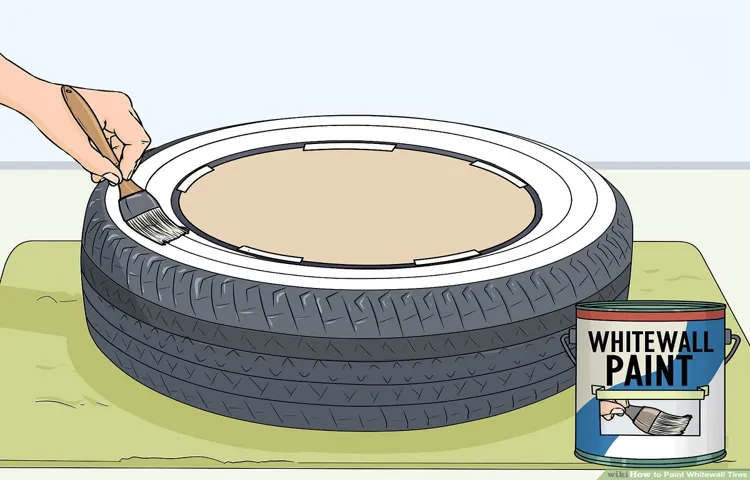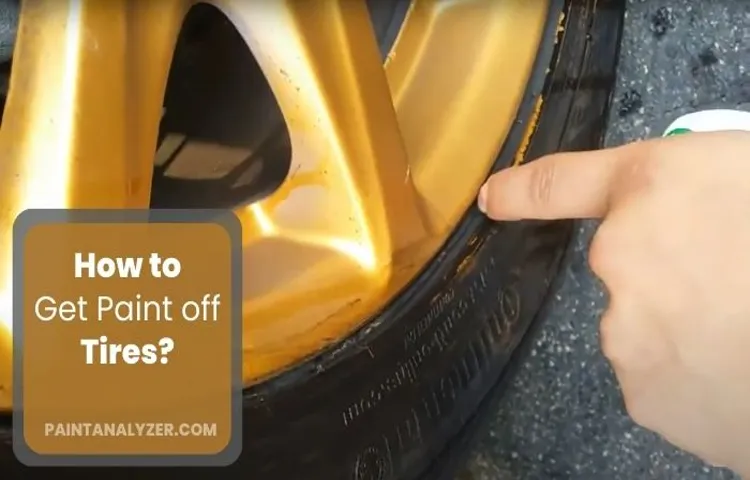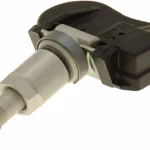Have you ever noticed unsightly paint marks on your tires? It’s frustrating, isn’t it? Not only does it detract from the appearance of your vehicle, but it can also be tough to remove. You may have tried different cleaning products, but to no avail. Well, fear not, my friend! In this guide, we’ll walk you through the process of removing paint from your tires, step-by-step.
We’ll cover everything from materials needed to different methods you can try. Whether you’re dealing with spray paint or road markings, we’ve got you covered. So, let’s get started and get those tires looking brand new again!
Table of Contents
Why It’s Important to Remove Paint From Your Tires
If you’re wondering how to get paint off a tire, it’s important to understand why it’s necessary in the first place. Paint on your tires can cause serious damage and affect the overall performance of your vehicle. Paint can also make it difficult to inspect your tires for wear and tear, leading to potential safety hazards.
Removing the paint can prevent further damage to your tires, preserving their durability, and lifespan. Plus, it can also improve the aesthetic look of your vehicle. The best way to remove paint from your tires is to use a specialized tire cleaner or solvent that is safe for use on rubber.
Avoid using abrasive materials as they can damage the tire surface. With some patience and elbow grease, you can get your tires looking brand new in no time.
Safety and Performance Issues
If you’re wondering why it’s important to remove paint from your tires, the answer is simple: safety and performance. When you have paint on your tires, it can affect the grip of the tire on the road, reducing your ability to brake and steer effectively. This is especially true in wet or icy conditions where the surface of the road is already slick.
Paint on your tires can also cause imbalances, leading to uneven wear, reduced fuel efficiency, and other performance issues. Riding with painted tires can make your vehicle vulnerable to accidents and damage, so it’s important to clean them off before hitting the road. Take care of your tires, and they’ll take care of you when you need them most.

Aesthetic Concerns
Removing paint from your tires may seem like a small detail, but it can make a big difference in the overall appearance of your vehicle. Not only can paint on your tires look unsightly, but it can also be a safety concern. Paint can affect the grip of your tires on the road, which can be dangerous when driving in wet or slippery conditions.
Additionally, paint on your tires can cause them to become unbalanced, leading to uneven wear and potentially damaging your suspension. By taking the time to remove any paint from your tires, you not only improve the aesthetic appeal of your vehicle but also ensure that it is safe to drive. So don’t neglect this small but important detail in your car maintenance routine.
Materials You’ll Need
If you’ve ever accidentally gotten paint on your tires, you probably know how difficult it can be to get it off! Luckily, there’s a solution – and you don’t even need any special tools! To get paint off of a tire, you’ll need a few simple materials: a bucket of warm water, dish soap, a scrub brush, and a clean rag. First, mix the dish soap into the warm water until it’s soapy. Then, use the scrub brush to gently scrub the affected area of your tire, making sure not to damage the rubber.
Finally, use the clean rag to wipe away any leftover soap and residue. With these easy steps, you’ll have those pesky paint stains removed from your tires in no time!
Protective Gear
If you’re going to engage in any potentially dangerous activity, wearing the right protective gear is crucial. But what exactly do you need? Here’s a breakdown of the essential materials you’ll need to keep yourself safe. First and foremost, you’ll want to invest in a quality helmet.
This is especially important for sports like biking or skiing where head injuries are a very real risk. Next up is body armor. Depending on the activity, you may need a full suit or just a vest, but either way, it should be made from high-quality impact-resistant materials and fit snugly to your body.
Gloves are another must-have, protecting your hands from scrapes, scratches, and burns. And last but not least, make sure you have the right footwear. Depending on the activity, you may need specialized shoes with extra grip or support.
Remember, the right gear can mean the difference between enjoying your activity safely and winding up with a serious injury. So don’t skimp on the materials you need to stay safe.
Cleaning Agents
When it comes to cleaning, having the right materials is key. You don’t want to start scrubbing away only to realize you don’t have all the tools you need. First on the list is a good set of gloves.
Whether you’re using harsh chemicals or just warm soapy water, gloves will protect your hands and keep them from getting dried out. Another essential item is microfiber cloths. These handy cloths are great for dusting, wiping down surfaces, and cleaning up spills.
They’re also reusable, so you don’t have to worry about constantly buying more. For tougher jobs, like scrubbing grime off of tile or cleaning an oven, you’ll need a heavy-duty cleaner. Look for a cleaner that’s specifically formulated for the surface you’re cleaning, and be sure to follow the instructions carefully.
With these items on hand, you’ll be ready to tackle any cleaning job that comes your way.
Step-by-Step Guide
If you find yourself with paint on your tire, don’t panic! While it may seem daunting to remove, it is actually a fairly simple process. First, gather your supplies: a bucket of warm water, a sponge, dish soap, and a scrub brush. Begin by soaking the affected area with the warm water to loosen the paint.
Next, apply a small amount of dish soap to the sponge and gently scrub the paint away. For stubborn areas, use a scrub brush. Be careful not to scrub too hard and damage the tire.
Once the paint is removed, rinse the tire thoroughly with clean water and dry with a towel. With these easy steps, you’ll have your tire looking as good as new without any trace of paint.
Step 1: Clean the Affected Area
When dealing with any type of damage caused by water, the first step in the cleanup process is to thoroughly clean the affected area. This means removing any standing water and drying out the space as much as possible. In addition, it’s essential to sanitize and disinfect the area to prevent mold growth and other potential health hazards.
Depending on the severity of the water damage, you may need to utilize specialized equipment and professional services to ensure that the area is properly cleaned and restored. By taking these steps to clean the affected area, you’ll be able to minimize further damage and create a safe and healthy environment for yourself and your loved ones. Make sure to put safety first and consider reaching out to a trained and experienced professional if needed.
Step 2: Apply the Cleaning Agent
Now that you have prepped the area you want to clean, it’s time to apply the cleaning agent. Before you start, make sure that you have the right solution for the job. Different cleaners work better for different types of dirt and cleaning surfaces.
Once you have your cleaning agent ready, apply it evenly over the surface you want to clean. The best way to do this is by using a spray bottle or a damp cloth. Make sure that you cover all the areas you want to clean and let the cleaning solution sit for a few minutes.
This gives the cleaner time to loosen up the dirt, making it easier to remove. Remember that using too much cleaning solution can lead to streaks and residue, so be careful not to over-saturate the area. With the right cleaner and the right amount of solution, your cleaning job will be a breeze.
Step 3: Scrub the Paint Off
After covering the surrounding areas with protective materials and selecting the appropriate paint stripper, it’s time to start scrubbing the paint off. As this can be a messy and time-consuming process, it’s important to approach it step-by-step. Start by applying the paint stripper with a brush or roller and leave it on for the recommended amount of time, which varies depending on the product and the thickness of the paint.
Then, use a scraper or putty knife to gently remove the softened paint. Take care not to damage the underlying surface. If necessary, repeat the process until all the paint is removed.
It’s important to wear protective gloves, goggles, and a respirator when using paint stripper, as it can be hazardous to your health. By following these steps and taking appropriate safety precautions, you can effectively remove the unwanted paint from your surfaces.
Preventing Paint From Sticking to Your Tires
If you’ve ever painted your car or have had work done by a body shop, you know how difficult it can be to prevent paint from sticking to your tires. It’s an annoying and unsightly problem that can be easily avoided with a few simple steps. One solution is to use a tire dressing or protectant before starting any painting work.
This will create a barrier between the tire and the paint, making it much easier to clean up any accidental paint drips later on. Another option is to cover the tires with a protective film or masking tape. This will completely shield the tires from any overspray or accidental paint drips.
When the painting process is complete, simply remove the film or tape and your tires will look as good as new! Remember, prevention is key when it comes to dealing with paint on your tires – a little bit of preparation goes a long way.
Avoiding Areas With Wet Paint
If you’re someone who cares about the appearance of your car, you probably go through great lengths to avoid areas with wet paint. However, even if you do your best to steer clear of freshly painted surfaces, it’s possible for paint to get on your tires. This can be frustrating, as paint can be difficult to remove and will leave unsightly marks on your car.
To prevent this from happening, there are a few things you can do. One of the most effective is to use tire covers whenever possible. These covers will protect your tires from any stray paint particles that might be in the air.
Additionally, you can also try applying a coat of wax to your tires before leaving your car. This will create a barrier between the paint and your tires, making it easier to wipe off any paint that may land on them. Overall, by being proactive and taking these steps, you can help prevent paint from sticking to your tires and keep your car looking great.
Washing Your Tires Often
Keeping your tires clean can help prevent paint from sticking to them. Washing your tires often can help remove any debris and dirt from the surface of the tire, creating a smooth surface that paint will have a harder time sticking to. On the other hand, dirty tires are more likely to have dirt or dust on their surface that can mix with the paint, leading to a bumpy, uneven surface that can be difficult to fix.
Additionally, a clean tire looks better on your car and can help prolong the life of your tires. So, take a few minutes to wash your tires every time you wash your car and you’ll be doing yourself and your tires a favor in the long run.
Final Thoughts
Getting paint off a tire might seem like a daunting task, but with a few simple steps, you can clean it off easily. Firstly, make sure to wear protective gloves to avoid any paint getting on your skin. Use a paint thinner or lacquer thinner to dissolve the paint on a small area of the tire.
Then, use a rag or a soft-bristled brush to scrub the area gently. Repeat this process until all the paint is removed. However, be careful not to use harsh chemicals that can damage the tire’s rubber.
Finally, rinse the tire with soap and water to remove any leftover residue. With these steps, your tires will look as good as new in no time!
Conclusion
In conclusion, getting paint off a tire is not rocket science, but it does require the right tools and a bit of elbow grease. Just remember to be patient, use a protective barrier when appropriate, and take care not to damage the rubber in the process. And if all else fails, just tell people that you intentionally painted your tires for that edgy, artsy look.
It’s all about owning your imperfections, right?”
FAQs
What are some common household items that can be used to remove paint from tires?
Some household items that can be used to remove paint from tires are rubbing alcohol, vinegar, and baking soda.
Is it safe to use a power washer to remove paint from tires?
It is not recommended to use a power washer to remove paint from tires as it can damage the rubber.
Can a professional detailing service remove paint from tires?
Yes, a professional detailing service can remove paint from tires using specialized products and techniques.
What is the best method for removing dried-on paint from tires?
The best method for removing dried-on paint from tires is to use a combination of solvents such as acetone and a wire brush to scrub it off.
Will removing paint from tires damage the tire’s integrity?
Removing paint from tires should not damage the tire’s integrity as long as the proper methods and products are used.
Can tire shine be used to cover up paint stains on tires?
Tire shine may temporarily cover up paint stains on tires, but it is not a recommended long-term solution.
Are there pre-made products specifically designed for removing paint from tires?
Yes, there are pre-made products specifically designed for removing paint from tires that can be found at auto supply stores.



